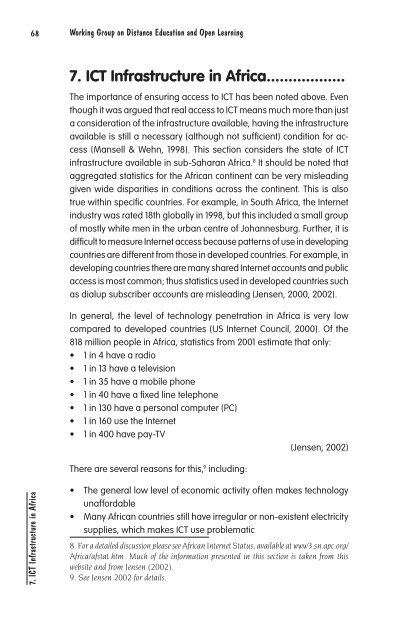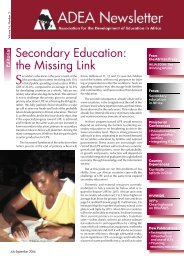Technological Infrastructure and Use of ICT in Education in ... - ADEA
Technological Infrastructure and Use of ICT in Education in ... - ADEA
Technological Infrastructure and Use of ICT in Education in ... - ADEA
You also want an ePaper? Increase the reach of your titles
YUMPU automatically turns print PDFs into web optimized ePapers that Google loves.
68 Work<strong>in</strong>g Group on Distance <strong>Education</strong> <strong>and</strong> Open Learn<strong>in</strong>g<br />
7. <strong>ICT</strong> <strong>Infrastructure</strong> <strong>in</strong> Africa..................<br />
The importance <strong>of</strong> ensur<strong>in</strong>g access to <strong>ICT</strong> has been noted above. Even<br />
though it was argued that real access to <strong>ICT</strong> means much more than just<br />
a consideration <strong>of</strong> the <strong>in</strong>frastructure available, hav<strong>in</strong>g the <strong>in</strong>frastructure<br />
available is still a necessary (although not sufficient) condition for access<br />
(Mansell & Wehn, 1998). This section considers the state <strong>of</strong> <strong>ICT</strong><br />
<strong>in</strong>frastructure available <strong>in</strong> sub-Saharan Africa. 8 It should be noted that<br />
aggregated statistics for the African cont<strong>in</strong>ent can be very mislead<strong>in</strong>g<br />
given wide disparities <strong>in</strong> conditions across the cont<strong>in</strong>ent. This is also<br />
true with<strong>in</strong> specific countries. For example, <strong>in</strong> South Africa, the Internet<br />
<strong>in</strong>dustry was rated 18th globally <strong>in</strong> 1998, but this <strong>in</strong>cluded a small group<br />
<strong>of</strong> mostly white men <strong>in</strong> the urban centre <strong>of</strong> Johannesburg. Further, it is<br />
difficult to measure Internet access because patterns <strong>of</strong> use <strong>in</strong> develop<strong>in</strong>g<br />
countries are different from those <strong>in</strong> developed countries. For example, <strong>in</strong><br />
develop<strong>in</strong>g countries there are many shared Internet accounts <strong>and</strong> public<br />
access is most common; thus statistics used <strong>in</strong> developed countries such<br />
as dialup subscriber accounts are mislead<strong>in</strong>g (Jensen, 2000, 2002).<br />
In general, the level <strong>of</strong> technology penetration <strong>in</strong> Africa is very low<br />
compared to developed countries (US Internet Council, 2000). Of the<br />
818 million people <strong>in</strong> Africa, statistics from 2001 estimate that only:<br />
• 1 <strong>in</strong> 4 have a radio<br />
• 1 <strong>in</strong> 13 have a television<br />
• 1 <strong>in</strong> 35 have a mobile phone<br />
• 1 <strong>in</strong> 40 have a fixed l<strong>in</strong>e telephone<br />
• 1 <strong>in</strong> 130 have a personal computer (PC)<br />
• 1 <strong>in</strong> 160 use the Internet<br />
• 1 <strong>in</strong> 400 have pay-TV<br />
(Jensen, 2002)<br />
There are several reasons for this, 9 <strong>in</strong>clud<strong>in</strong>g:<br />
7. <strong>ICT</strong> <strong>Infrastructure</strong> <strong>in</strong> Africa<br />
• The general low level <strong>of</strong> economic activity <strong>of</strong>ten makes technology<br />
unaffordable<br />
• Many African countries still have irregular or non-existent electricity<br />
supplies, which makes <strong>ICT</strong> use problematic<br />
8. For a detailed discussion please see African Internet Status, available at www3.sn.apc.org/<br />
Africa/afstat.htm. Much <strong>of</strong> the <strong>in</strong>formation presented <strong>in</strong> this section is taken from this<br />
website <strong>and</strong> from Jensen (2002).<br />
9. See Jensen 2002 for details.

















